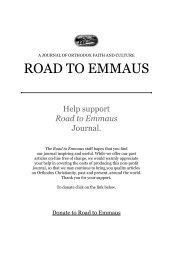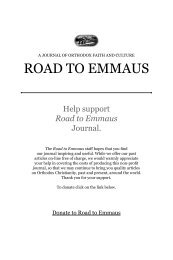RTE No 20 Interior - Road to Emmaus Journal
RTE No 20 Interior - Road to Emmaus Journal
RTE No 20 Interior - Road to Emmaus Journal
Create successful ePaper yourself
Turn your PDF publications into a flip-book with our unique Google optimized e-Paper software.
<strong>Road</strong> <strong>to</strong> <strong>Emmaus</strong> Vol. VIII, <strong>No</strong>. 4 (#31)FAITH UNSEENshaken. Daily life was disrupted and rumors and theories were rife.Everyone, though, agreed that this was a sign from God, and not a good one.Metropolitan Dionysios (Kazanos) of Chaldia (1757-1783), a well-educatedman, managed <strong>to</strong> calm his flock with a short and simple treatise explainingthe natural phenomenon, which was distributed <strong>to</strong> all the churches of hisdiocese, and then throughout Pontus. Impressed that the Christian populationhad ceased <strong>to</strong> be troubled, the Turkish authorites asked that the treatisebe translated and read in all the villages and <strong>to</strong>wn squares. The Muslimsalso were pacified, and life went back <strong>to</strong> normal.Another tradition of the area was the Hortlak, which means “ghost.” Thepeople of Kromni believed that anyone who died without paying his debtscould not rest in peace, and at night would arise from the grave, crying andshouting, until his family paid what he owed. After the debts were settled,the priest would do a small service or read prayers over the grave.Hearing these s<strong>to</strong>ries from Aphrodite, it seemed peculiar <strong>to</strong> me that themost common Hortlak were Ot<strong>to</strong>mans, and at night everyone could heartheir deceased Turkish neighbor shouting as a Hortlak. The Ot<strong>to</strong>man relativeslistened <strong>to</strong> these s<strong>to</strong>ries and after some time they themselves beganhearing the voice of their dead, after which they quickly settled the debts. Ibelieve that this was a clever trick of the Christians <strong>to</strong> make the Turks repaytheir debts, but when I asked Aphrodite, she emphatically answered in thenegative. She insisted that the Hortlak existed and they could be eitherChristian or Turk. Christians, also, who left unsettled debts <strong>to</strong> eitherChristians or Turks could not rest until they were settled. It was divine justicedemanding recompense, she believed, not a trick.Another peculiarity was that even the Turkish Muslim families <strong>to</strong>ok anOrthodox priest with them <strong>to</strong> the Muslim cemeteries for a short prayer serviceover the grave after the debts were paid. Pontians believed these s<strong>to</strong>riesand if an Ot<strong>to</strong>man consulted his Muslim mullah about it, he was assuredthat the Hortlak really did exist. People not only heard, but saw them, andfor this reason no one ventured out after dark without good reason. And noone ever went near a cemetery at night.Cryp<strong>to</strong>-Christian Burial PracticesThere was also, for us, the humorous and long-standing belief of theTurkish Muslims in the surrounding areas that the air of Kromni was verygood because no one ever died there! This was because the cryp<strong>to</strong>-Christiansheld their funerals after dark in their house chapels. In the countryside, peoplehad (and still have) the legal right <strong>to</strong> bury the dead on their own property,so in Kromni, the cryp<strong>to</strong>-Christians were buried with Orthodox rites intheir own gardens. Muslim outsiders never saw the burial services.In larger <strong>to</strong>wns or cities, however, this wasn’t allowed, so they had <strong>to</strong> burythe supposed Muslims in the Muslim graveyard. In the Muslim communitywere specialists who prepared the body for burial, and it would have beensuspicious if a family did not call them or refused <strong>to</strong> follow Muslim burialpractices. As part of the burial service, Muslims wash their dead in extremelyhot water, hotter than anyone living could bear.This presented a problem for cryp<strong>to</strong>-Christian men because of the traditionamong Muslims of circumcising their young boys. 8 Muslim attendants preparingthe body of an uncircumcised cryp<strong>to</strong>-Christian man for burial wouldimmediately understand that this man had been a Christian. Instead, the cryp<strong>to</strong>-Christiansin the cities often used an alternative Muslim funeral cus<strong>to</strong>mcalled aptest, when, immediately after death, they sewed the body in<strong>to</strong> a whiteshroud which was not opened again. Instead of a funeral casket, there was awooden bier. The dead person was placed upon the bier and taken <strong>to</strong> the porchof the mosque, where he was positioned with only his feet in the entryway –his head pointed outwards. They recited the prayers and verses from theKoran and then buried the shrouded body directly in the earth.Kromni’s Churches Res<strong>to</strong>redAlthough, as I mentioned, the first mosque was erected in Kromni in 1815,the first church was only built sixteen years later by professed Christianswho had begun moving <strong>to</strong> the area in the 1700s <strong>to</strong> work in the mines. Thischurch came about during the reign of Sultan Mahmud Han II (1808-1839),who decreed that ruined Christian churches might be res<strong>to</strong>red. As theremains of a 13th-century church could still be seen in the Kromnean villageof Samanandon, the cryp<strong>to</strong>-Christians encouraged the professed Christians<strong>to</strong> petition the Sultan <strong>to</strong> allow them <strong>to</strong> rebuild.The Sultan sent his approval in a firman (decree) in 1830, stating that,“those who petitioned and begged for the res<strong>to</strong>ration of the ruined church at8 Cryp<strong>to</strong>-Christian men were not always uncircumcised. In communities where it was impossible <strong>to</strong> escapethe scrutiny of Muslim neighbors, a male cryp<strong>to</strong>-Christian child would be secretly baptized and chrismated,and at the proper age also undergo Muslim circumcision, so as not <strong>to</strong> arouse suspicion.3637










